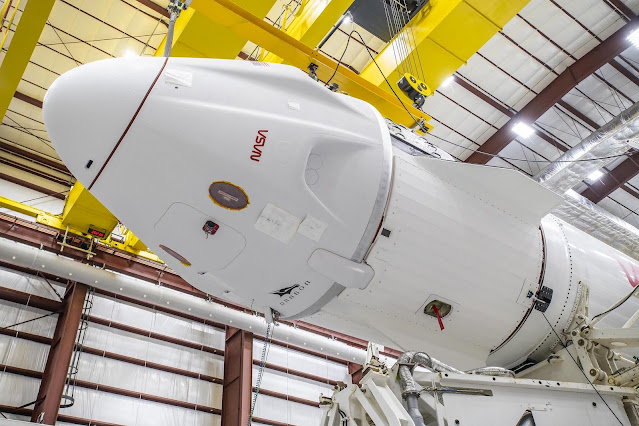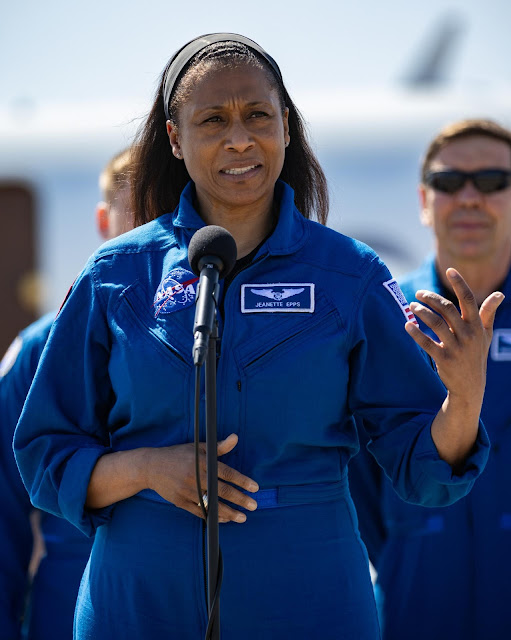NASA's SpaceX Crew-8 Arrives at Kennedy Space Center Ahead of Launch
Crew members of NASA’s SpaceX Crew-8 mission to the International Space Station from right to left NASA astronauts Michael Barratt, Matthew Dominick, and Jeanette Epps, and Roscosmos cosmonaut Alexander Grebenkin of Russia, stand before members of the news media at the Launch and Landing Facility at Kennedy Space Center in Florida on Sunday, Feb. 25, 2024
Crew members of NASA’s SpaceX Crew-8 mission to the International Space Station from right to left NASA astronauts Jeanette Epps, Matthew Dominick, and Michael Barratt, and Roscosmos cosmonaut Alexander Grebenkin of Russia
NASA astronaut Jeanette Epps, Crew-8 mission specialist, delivers remarks to members of the news media
NASA astronaut Matthew Dominick, Crew-8 commander, delivers remarks to members of the news media
NASA astronaut Jeanette Epps, Crew-8 mission specialist, smiles during crew arrival for NASA’s SpaceX Crew-8 mission

NASA astronaut Michael Barratt, Crew-8 pilot, delivers remarks to members of the news media
Roscosmos cosmonaut Alexander Grebenkin of Russia, Crew-8 mission specialist, delivers remarks to members of the news media
Four Commercial Crew members representing the SpaceX Crew-8 mission arrived at the Launch and Landing Facility at NASA's Kennedy Space Center in Florida on Sunday, Feb. 25, 2024. They are preparing for their launch to the International Space Station aboard the SpaceX Dragon Endeavour spacecraft. Commander Matt Dominick (NASA), Pilot Mike Barratt (NASA), and Mission Specialists Jeanette Epps (NASA) and Alexander Grebenkin of Roscosmos (Russia) will lift off aboard Dragon no earlier than 12:04 a.m. EST on Friday, March 1, 2024. They are scheduled to dock at the Harmony module’s forward port at 6 a.m. on Saturday beginning a six-month space research mission on the orbital lab.
Learn more about the SpaceX Crew-8 Mission:
NASA Astronaut Jeanette Epps Official Biography:
https://www.nasa.gov/astronauts/biographies/jeanette-j-epps/biography
NASA Astronaut Matthew Dominick Official Biography
https://www.nasa.gov/people/matthew-dominick
NASA Astronaut Michael Barratt Official Biography
https://www.nasa.gov/astronauts/biographies/michael-reed-barratt/biography
Alexander Grebenkin graduated from Irkutsk High Military Aviation School, Irkutsk, Russia, majoring in engineering, maintenance, and repair of aircraft radio navigation systems. He graduated from Moscow Technical University of Communications and Informatics with a degree in radio communications, broadcasting, and television.
NASA’s Commercial Crew Program works with the American aerospace industry to provide safe, reliable, and cost-effective transportation to and from the orbital outpost on American-made rockets and spacecraft launching from American soil.
An international partnership of space agencies provides and operates the elements of the International Space Station (ISS). The principals are the space agencies of the United States, Russia, Europe, Japan, and Canada. The ISS has been the most politically complex space exploration program ever undertaken.
Image Credit: NASA's Kim Shiflett
Image Date: Feb. 25, 2024
#NASA #Space #Science #ISS #SpaceX #SpaceXCrew8 #CrewDragonSpacecraft #Earth #Astronauts #MatthewDominick #MichaelBarratt #JeanetteEpps #Cosmonaut #AleksandrGrebenkin #LongDurationMission #HumanSpaceflight #CommercialSpace #KSC #Spaceport #Florida #UnitedStates #Russia #Россия #Роскосмос #Expedition70 #Expedition71 #STEM #Education



















RD.jpg)
.jpg)
